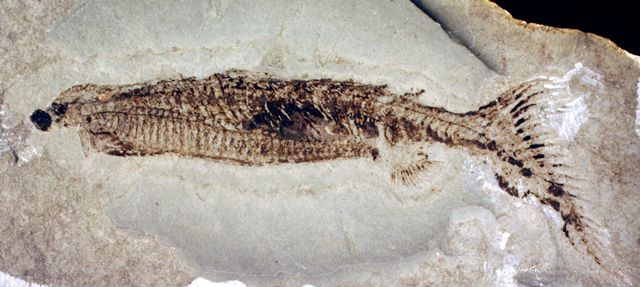It looks like you're using an Ad Blocker.
Please white-list or disable AboveTopSecret.com in your ad-blocking tool.
Thank you.
Some features of ATS will be disabled while you continue to use an ad-blocker.
4
share:
Fish fossil from ancient Canada sheds new light on limb evolution in human ancestors
A fossilized fish from ancient Canada is being hailed in a new British study as a rare portal to a key moment in evolution, when humanity’s primitive ancestors were “experimenting” with traits that would become fundamental to the diverse family of vertebrate animals.
Among those features are paired appendages — the mirrored arms and legs of many mammals — and a 370-million-year-old, long-extinct fish species discovered at a world-famous Quebec fossil site has been described as one of the earliest known exhibitors of such duality in a jawless fish.
The fossil creature, Euphanerops longaevus, thrived during the Devonian era — the so-called “Age of Fishes” — when marine animals were developing ever-more complex variations, and some of them evolved into the “lobe-finned” precursors of land vertebrates.
Perhaps the most famous of those lobe-finned fish — the Ellesmere Island fossil species Tiktaalik roseae, discovered in 2006 — has helped scientists bridge the gap between fish and the earliest tetrapods, the four-footed creatures that eventually encompassed dinosaurs, deer and humans and which would come to dominate life on land.
But Euphanerops longaevus, first unearthed in 1900 at the renowned Miguasha fossil site on Quebec’s Gaspé Peninsula, represents a time when even simple, jawless fish were evolving novel anatomical structures as organisms worked out the optimal arrangements of fins and limbs.
source
From ocean to land: The fishy origins of our hips
New research has revealed that the evolution of the complex, weight-bearing hips of walking animals from the basic hips of fish was a much simpler process than previously thought. Tetrapods, or four-legged animals, first stepped onto land about 395 million years ago. This significant change was made possible by strong hipbones and a connection through the spine via an ilium -- features that were not present in the fish ancestors of tetrapods.
In a study published in the journal Evolution and Development, Dr Catherine Boisvert of the Australian Regenerative Medicine Institute at Monash University, MacQuarie University's Professor Jean Joss and Professor Per Ahlberg of Uppsala University examined the hip structures of some of human's closest fish cousins.
They found the differences between us and them are not as great as they appear -- most of the key elements necessary for the transformation to human hips were actually already present in our fish ancestors.
Dr Boisvert and her collaborators compared the hip development -- bones and musculature -- of the Australian lung fish and the Axolotl, commonly known as the Mexican Walking Fish. The results showed that, surprisingly, the transition from simple fish hip to complex weight-bearing hip could be done in a few evolutionary steps.
"Many of the muscles thought to be 'new' in tetrapods evolved from muscles already present in lungfish. We also found evidence of a new, more simple path by which skeletal structures would have evolved," Dr Boisvert said.
The researchers found that the sitting bones would have evolved by the extension of the already existing pubis. The connection to the vertebral column could have evolved from an illiac process already present in fish.
"The transition from ocean-dwelling to land-dwelling animals was a major event in the evolution of terrestrial animals, including humans, and an altered hip was an essential enabling step," Dr Boisvert said.
science news
I tried to upload the pic of the fossil but I couldn’t.
These two articles in combination help bridge the gap in evolution from a time when life moved out of the sea. As time goes on I expect more fossil evidence will be found. To me it is pretty amazing that they are able to find any considering the unique conditions that need to be met to preserve them to be discovered millions of years later.
Much more information found in the source articles.
new topics
-
Just Sick of It! Done! Can't take it anymore!
General Chit Chat: 8 minutes ago -
Speaking of Pandemics
General Conspiracies: 1 hours ago -
Stuck Farmer And His Queue Jumping Spawn
Rant: 1 hours ago -
Paradox of Progress
Ancient & Lost Civilizations: 10 hours ago
4

